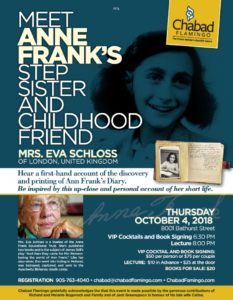On Oct. 4, Holocaust survivor Eva Schloss will be speaking at Chabad Flamingo in Thornhill, Ont.
Schloss, nee Geiringer, is perhaps best known for being the stepsister of Anne Frank. The two were never stepsisters while Frank was alive, as Schloss’ mother, Elfriede, married Frank’s father, Otto, after the war. They did, however, know each other for about two years before they were forced into hiding with their families.
Schloss will be speaking about her time living in Nazi-occupied Europe, hiding in Amsterdam and surviving Auschwitz.
She was born in Vienna in 1929 and lived there until she was nine years old, when the Nazis occupied Austria. From there, her family moved to Belgium, and then went to Amsterdam, where Schloss met Frank. The Geiringers arrived in Amsterdam in February 1940 and the city was occupied in May of that year.
READ: ANNE FRANK’S STEPSISTER RECALLS A ‘VERY LIVELY GIRL’
“Then it became very, very difficult for Jewish people. I had an older brother, and especially for young men, it was dangerous to go out, (due to) all the measures against Jewish people,” said Schloss.
As difficult as it was at the time, the families were not yet forced into hiding. Over two years, from 1940 to 1942, Schloss and Frank became friends.
“The (Frank) family left (Frankfurt) already when she was four years old, in ’33, so she didn’t experience anti-Semitism,” Schloss said of Frank. “She set up very quickly in Holland, learned the language, so she felt very much at home there. And so she was very sure of herself, very chatty, had already very impressive different levels, already very interested in boys. So I was sort of admiring her because I had become quite shy. But she was very daring and very lively.”
In 1942, when both Schloss and Frank were 13, their families decided to go into hiding. Frank famously hid with her family in an attic, along with four other Jews. Meanwhile, Schloss’s family of four was split up: she hid with her mother, while her brother hid with her father.

“I started to cry. I didn’t want to be separated. And my father said the chance that two of us will survive is bigger if you are in different places,” she said. “And when I was 13, I realized for the first time that it might mean death. And that was, of course, for a 13-year-old child, quite a frightening idea.”
After two years in hiding, the Geiringers were betrayed and sent to Auschwitz, where they were again separated by gender.
“It was amazing that anybody should survive, because we’re not supposed to survive. Starvation, hard labour, illnesses, cholera, dysentery, typhus, you know, it was really, really, really not meant that anybody would come out alive,” Schloss said of the camp.
But she did survive, as did her mother. Ironically, they were saved by being too weak to leave the camp when the Germans fled in anticipation of its impending liberation by the Russians.
Had Schloss and her mother left, they might have perished on what came to be known as a death march. They were scared to stay, because there was a rumour that the Germans would burn the camps to the ground behind them. But it was impossible for them to go in their condition.
The two were liberated by the Russians and eventually made their way back to Amsterdam. That’s where Schloss learned that her brother and father had died on a death march.
Schloss didn’t speak about her experiences until 1985, 40 years after the fact. In the intervening time, she got married to Zvi Schloss and had three daughters. Even they didn’t learn the details of her past, until she published her first book, Eva’s Story, about the Nazi occupation, the concentration camp and her experiences after the war.
She also published two other books: After Auschwitz and The Promise.
